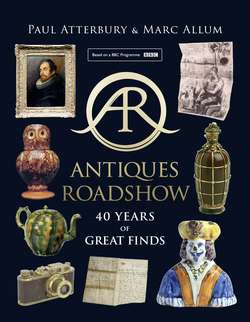Читать книгу Antiques Roadshow: 40 Years of Great Finds - Paul Atterbury, Paul Atterbury - Страница 15
A DELFTWARE TURK’S HEAD
Оглавление‘I know nothing about it – it just lives on the mantelpiece. It isn’t even insured.’
When the Roadshow visited Birmingham in 2000, the highlight of the day turned out to be a small pottery head and shoulders model of a Turk wearing a turban. Crudely modelled and brightly coloured, it seemed at first sight to be only of limited interest. However, John Sandon knew better, recognising it at once as an extremely unusual example of early English Delftware.
Delft is a widely used term to describe earthenware covered with an opaque, white, tin glaze and then freehand painted in blue and other colours. Also known as faience and maiolica, this type of pottery was made in many countries from the Middle Ages to the nineteenth century. Spain, Italy, France, Germany and Holland were the main centres of production, with the term Delft, or Delftware, reflecting the Dutch origins of many of the styles, shapes and designs. The inspiration was mostly Far Eastern, with the white-glazed pottery being a crude attempt at imitating the look of white Chinese porcelain. At the same time, the Middle East was also important, with many styles echoing the period of Islamic domination in southern Europe.
AN EXTREMELY RARE EXAMPLE
Dutch and Italian potters probably brought the technique to Britain in the seventeenth century and, for a while, blue and white and polychrome Delftware was the most significant type of pottery made in Britain between the 1650s and the early eighteenth century. It was then replaced by the much improved white earthenwares and creamwares developed in Staffordshire from the 1730s. There were a number of Delftware production centres, although the main ones were in London, Liverpool and Bristol. Most potters produced functional domestic pottery, plates, dishes, bowls, mugs and tiles, with blue being the dominant colour. However, ceremonial chargers and punchbowls were also made, some with complex polychrome decoration that sometimes echoed Chinese styles and others with royal portraits or biblical scenes.
The young lady owner who had brought in the Turk figure knew nothing about it, other than that her aunt had lived in the same house since the 1920s, and had always had it on the mantelpiece until she died, aged 94. When the owner inherited it, she had thought nothing of it but had kept it because her aunt had liked it.
John Sandon then told her about English Delftware, and identified the Turk’s head model as an extremely rare and early example, probably dating from the late seventeenth century. Although tin-glazed figure models were not unusual in Italy, France or Holland, very few were made by British potters. A number were recorded, including figures of Charles I and Apollo, along with a curious comic character called No-Body, from a play called No-Body and Some-Body, published in 1606. Also popular were cats, both seated and lying down, with a version of the seated cat serving as a jug. John explained that the Turk’s head was particularly unusual and, though it had a maker’s mark on the base, he was not able to identify it.
A FAMILIAR MOTIF
The Turk’s head is a familiar decorative motif in British history, with its origins probably linked to the Crusades. All over Britain, and particularly in sea ports, there are pubs called The Turk’s Head. There is also a knot called a Turk’s Head, and decorative pottery and porcelain featuring Turkish-style figures was popular throughout the eighteenth and nineteenth centuries. This Delftware Turk’s head was probably inspired by a European model, and thus may have been made by a potter with European connections. Despite some chips and minor damage – not unusual with Delftware – John was confident that the Delftware Turk’s head would fetch £50,000.
Sometime later, the Turk’s head appeared in a ceramics sale at the auctioneers Phillips in London, but failed to sell. It was then sold privately to an American collector, via a leading London dealer who specialised in early English pottery, for a sum roughly equivalent to John’s Roadshow valuation. At the time, it was one of the most important examples of early English pottery to have been discovered by the Roadshow.
